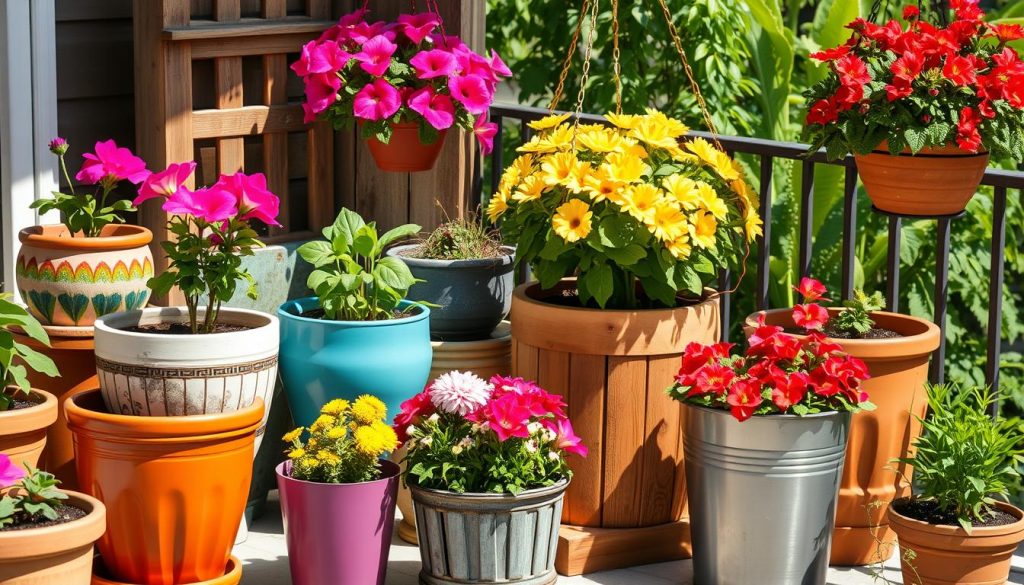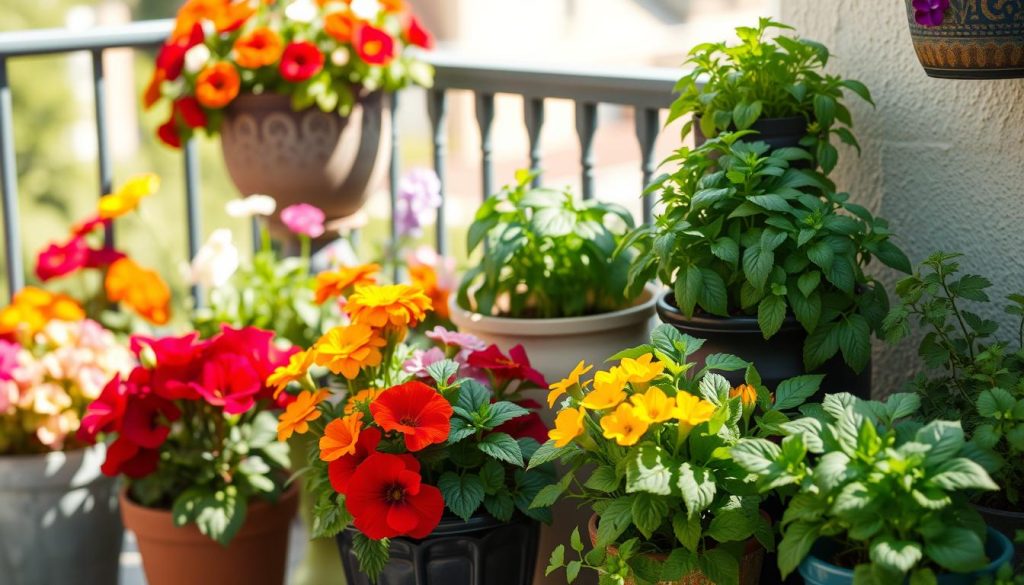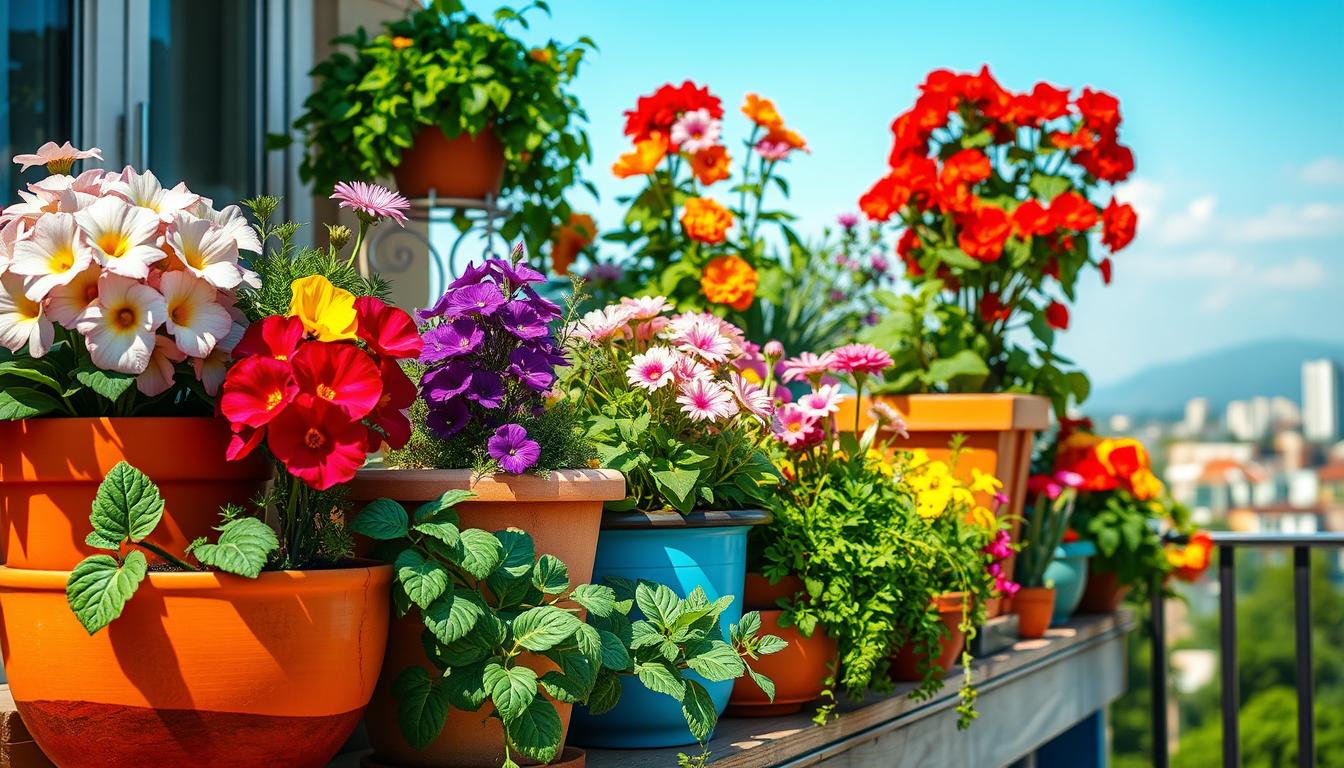I’m excited to share with you the world of Container Gardening. Here, you can create a thriving oasis in even the smallest of spaces. It’s perfect for small space gardening and urban gardening.
Container Gardening is a great way to bring greenery into your life. It offers many benefits, making it ideal for urban and small space gardening.
What Is Container Gardening?
Container gardening is a fantastic way to grow plants, even with little space. It lets you control the soil and cut down on weeds. Plus, you get to enjoy fresh fruits and veggies right from your garden.
One cool thing about container gardening is you can move your plants around. This makes it easy to change up your garden’s look. You can use big containers for trees and small ones for herbs or flowers.
Definition and Basics
Container gardening means growing plants in pots, planters, or boxes. It’s great for small spaces because you can grow many plants in a little area. You can even have a balcony garden or a kitchen garden to grow herbs, veggies, and fruits.

Benefits of Container Gardening
Some perks of container gardening include:
- Control over soil quality
- Reduced weed growth
- Increased crop yield
- Portability and flexibility
- Aesthetically pleasing
Container gardening is a wonderful way to grow plants, whether you have a tiny balcony or a big kitchen garden. With the right containers and care, you can harvest fresh fruits and veggies. Plus, you can make your outdoor space look beautiful with potted plants.
| Type of Container Garden | Benefits |
|---|---|
| Balcony Gardening | Space-saving, easy to maintain |
| Kitchen Garden | Fresh produce, convenient location |
| Potted Plants | Portable, visually appealing |
Why I Love Container Gardening
I’m passionate about container gardening and it brings me joy. It connects me to nature, whether I’m gardening indoors, on my patio, or in a small space.
Connection to Nature
Nurturing plants and watching them grow is rewarding. It’s especially important in today’s world, where we often feel disconnected from nature.
Therapeutic Benefits
Container gardening also has many health benefits. It can reduce stress, improve mood, and make us feel better overall. These benefits are true for indoor, patio, and small space gardening.
Some of the benefits of container gardening include:
- Reduced stress and anxiety
- Improved mood
- Increased sense of well-being
- Connection to nature

By adding indoor, patio, and small space gardening to your life, you can enjoy these benefits. Container gardening brings many joys.
| Type of Gardening | Benefits |
|---|---|
| Indoor Gardening | Improved air quality, reduced stress |
| Patio Gardening | Increased outdoor space, improved mood |
| Small Space Gardening | Maximized space, increased sense of well-being |
Choosing the Right Containers
Urban gardening needs the right containers for healthy potted plants. As a fan of container gardening, I know the material, size, and shape matter a lot. These factors can make or break your gardening project.
The material of your container is key. You can pick from clay, plastic, or wood. Each has its own good points and downsides. Clay helps with moisture, plastic is light, and wood adds style.
Materials to Consider
- Clay: breathable, regulates soil moisture
- Plastic: lightweight, easy to move
- Wood: adds elegance, can be durable
The size of your container is also crucial. It depends on the plant and the space you have. Choose a size that fits your plant’s mature size and your space.

Size Matters
Choosing the right container ensures your plants get what they need. Think about your plants’ needs and your space when picking a container. The right one will make your container garden thrive and look great.
Best Plants for Container Gardening
Choosing the right plants is key for a great balcony garden. For a kitchen garden or small space, pick plants that are compact and easy to care for. They should also produce a lot. We’ll look at top picks for container gardening, including herbs, veggies, flowers, and foliage.
Herbs like basil, mint, and cilantro are perfect for a kitchen garden. They grow easily and need little care. They’re great in many dishes. For veggies, cherry tomatoes, leaf lettuce, and radishes work well in small spaces and containers.
Popular Plants for Container Gardening
- Herbs: basil, mint, cilantro, parsley
- Vegetables: cherry tomatoes, leaf lettuce, radishes, carrots
- Flowers: petunias, geraniums, marigolds, zinnias
- Foliage: ferns, ivy, succulents, grasses
Think about sunlight, water, and soil when picking plants for your garden. With the right plants and care, your balcony or small space garden will be beautiful and productive. It will add joy and freshness to your outdoor area.

| Plant | Sunlight Requirements | Water Requirements |
|---|---|---|
| Basil | Full sun | Regular watering |
| Cherry Tomatoes | Full sun | Regular watering |
| Petunias | Partial shade | Infrequent watering |
Soil and Drainage Tips
Soil and drainage are key in container, indoor, and patio gardening. The right soil mix is vital for plant health. I’ll share tips on choosing the best soil and ensuring good drainage for your garden.
In container gardening, a well-draining potting mix is crucial. It prevents waterlogged soil and root rot. Use a mix with peat moss, vermiculite, and perlite. These materials keep moisture, suppress weeds, and improve drainage.
Choosing the Right Soil Mix
Look for soil mixes designed for indoor and patio gardening. A good mix should have:
- Good drainage
- High organic matter content
- pH level suitable for your plants
With the right soil mix and drainage, your container garden will thrive. These tips are helpful for both new and experienced gardeners.
Watering Techniques for Success
Watering is key in urban, balcony, and small space gardening. Too much water can harm your plants as much as too little. Finding the right balance is crucial for a healthy container garden.
Frequency and Amount
The amount of water needed varies by plant type, container size, and climate. Generally, water when the top inch of soil feels dry. In hot weather, urban gardens might need daily watering. But balcony gardens might need less due to wind and sun.
Signs of Over or Under-Watering
Knowing the signs of too much or too little water is important. Yellow leaves, droopy stems, or soft soil are signs of over-watering. Under-watering shows in brittle, crispy leaves. Watch your plants closely and adjust watering to keep them healthy in small spaces.
Fertilizing Container Plants
Exploring container gardening has shown me how vital fertilizing is. It’s key for both indoor and patio gardening. Fertilizing keeps the soil rich with nutrients, which plants need to grow.
There are many fertilizers to pick from, like organic and inorganic ones. Balanced, high-phosphorus, and organic fertilizers like compost are popular. It’s important to pick the right one for my plants and use it as directed.
Types of Fertilizers
- Balanced fertilizers: These have equal nitrogen, phosphorus, and potassium. They’re good for most plants in containers.
- High-phosphorus fertilizers: These are best for plants that need more phosphorus, like flowers and fruiting plants.
- Organic fertilizers: Made from natural stuff like compost, manure, or fish emulsion. They’re eco-friendly and great for container gardening.
When to Apply
Fertilizing frequency depends on the fertilizer and plant needs. I usually fertilize my plants once a month when they’re growing. But, some fertilizers need more often, so always check the instructions. Regular fertilizing helps my plants grow well in indoor or patio gardens.
Sunlight Requirements
As I explore container gardening, I’ve learned sunlight is key for plant growth. It’s vital whether I’m gardening in the city, on a balcony, or in a small space. Most plants need 4-6 hours of direct sunlight daily. Some can do well in partial shade or indirect light.
Direct sunlight is best for plants needing lots of energy, like tomatoes or roses. But, plants like ferns or peace lilies do better in partial shade. To get the right light, I use shading and reflection. I place sun-loving plants in south-facing spots and shade lovers in north-facing ones.
- During summer, give more shade to plants sensitive to strong sunlight.
- In winter, move plants to sunnier spots to make up for shorter days.
- Use mirrors or reflective surfaces to bounce sunlight to plants needing it.
By following these tips, I can make my container garden flourish. It brings joy and beauty to my urban, balcony, or small space garden.
Designing My Container Garden
When I start designing my container garden, I think about balance, proportion, and harmony. I aim to make a beautiful space, whether it’s for my patio or indoors. Container gardening lets me be creative with my garden’s look and feel.
Arranging Plants for Aesthetics
I pick plants based on their texture, color, and size. Mixing plants with different growth habits adds depth and interest. For example, I pair tall plants like succulents with trailing ones like ivy or creeping thyme.
This mix creates a stunning, layered look. It makes my patio garden more visually appealing.
Companion Planting for Success
Companion planting is key in my garden design. I choose plants that work well together, like marigolds with tomatoes to fight nematodes. Basil with lettuce improves the lettuce’s taste.
This approach makes my garden beautiful and healthy. It also cuts down on the need for harmful chemicals.
With some creativity and planning, I can make a beautiful container garden. It brings joy and beauty to my space, whether indoors or outdoors. Container gardening is full of possibilities for anyone, from beginners to experienced gardeners.
| Plant | Companion Plant | Benefits |
|---|---|---|
| Tomatoes | Marigolds | Deters nematodes |
| Lettuce | Basil | Improves flavor |
| Peppers | Onions | Deters pests |
Common Pests and Diseases
As I enjoy my urban gardening, I’ve found that pests and diseases can still hit my plants. This is true for balcony and small space gardens, where plants are more exposed. It’s key to spot problems early to stop them from spreading.
Identifying Issues
Common pests like aphids, whiteflies, and spider mites can harm container gardens. Diseases such as root rot, leaf spot, and powdery mildew can also strike. I check my plants often for signs like yellow leaves, black spots, or webbing.
Natural Remedies and Solutions
Fortunately, natural solutions can help fight pests and diseases in urban gardens. Organic pesticides and fungicides work well, as do beneficial insects. Neem oil and insecticidal soap are great for controlling pests.
By preventing pests and diseases and using natural remedies, I keep my container garden healthy. Even in a small space, my garden thrives.
Seasonal Container Gardening Tips
Container gardening is a hobby that can be enjoyed all year. Whether you’re growing plants indoors or outdoors, each season offers its own challenges and opportunities. By adjusting your gardening habits and preparing your containers for the weather, you can keep your garden thriving.
Adjusting for Weather Changes
As the seasons change, so must your gardening. In spring, watch out for sudden cold snaps and protect your plants. In summer, water more and place containers in the shade to keep plants healthy. For fall, prepare your containers for winter by mulching, pruning, and choosing hardy plants.
Preparing for Each Season
Good container gardening starts with planning. In winter, check your soil, fix any container damage, and pick plants for the next year. As spring comes, start seedlings indoors and plan your garden’s layout. Each season is a chance to refresh your garden and explore new ways to enjoy nature at home.

